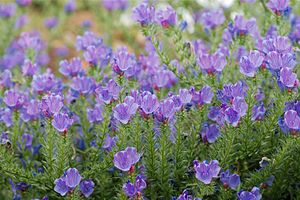Plantain-leaved adder's head
| Plantain-leaved adder's head | ||||||||||||
|---|---|---|---|---|---|---|---|---|---|---|---|---|

Plantain-leaved adder's head ( Echium plantagineum ) |
||||||||||||
| Systematics | ||||||||||||
|
||||||||||||
| Scientific name | ||||||||||||
| Echium plantagineum | ||||||||||||
| L. |
The Wegerichblättrige Natternkopf ( echium plantagineum ), even plantain Natternkopf called, is a species of the family of Borage Family (Boraginaceae).
Another regional name was Ochsenmaul ( Mark Brandenburg ) in the 19th century .
description
Vegetative characteristics
The plantain-leaved adder head is an annual or biennial or perennial herbaceous plant and reaches heights of 20 to 60 centimeters. The aboveground parts of the plant are hairy with soft bristles.
The long-stalked and ovate-spatulate basal leaves are arranged in a rosette similar to plantain. They have raised veins and are up to 14 centimeters long. The seated stem leaves have a heart-shaped base and enclose the stem up to halfway.
Generative characteristics
The flowering period extends from April to July. The hermaphrodite flowers are five-fold with a double flower envelope . The crown is 18 to 30 millimeters long and is blue, later purple-pink and broadly funnel-shaped. Two of the five stamens protrude from the flower.
The nuts are warty.
The number of chromosomes is 2n = 16.
Occurrence
This Mediterranean species is found throughout the Mediterranean and parts of North Africa, Western Asia and Western Europe (from north to southwest England ) as well as on the Canary Islands , Azores and Madeira . The preferred locations are roadsides, dry fallow land and sandy soils near the coast. Echium plantagineum is a harmful neophyte in North America and Australia .
Invasive plant and toxicity
Echium plantagineum is naturalized in the USA. Stocks are known in parts of the western states such as California and Oregon , but also in northern Michigan . Oregon has Echium plantagineum on List A and List T as a harmful weed (invasive species). The occurrences (first discovered in 2003) are locally limited and are under observation or are contained (as of 2012). The population is called upon to control the plants in new areas of distribution and to report them.
In Australia belongs Echium plantagineum to the invasive species . Importation is strictly prohibited. The south of the continent is particularly hard hit. In the drought months, the species grows better than other green fodder. Horses eat the plants and get chronic liver damage from the plant toxins. After a large bush fire in Canberra in early 2003 , the species found the best growing conditions, which significantly increased the disease rate among horses. Most horses die six months after eating the plants.
Taxonomy
Echium plantagineum L. has the synonyms: Echium lycopsis auct. non L. , Echium maritimum Willd. , Echium murale Hill , Echium plantaginoides Roem. & Schult. , Echium sennenii Pau .
literature
- Dankwart Seidel: Flowers on the Mediterranean. Determine accurately with the 3-check . BLV, Munich 2002, ISBN 3-405-16294-7 .
Individual evidence
- ^ Georg August Pritzel , Carl Jessen : The German folk names of plants. New contribution to the German linguistic treasure. Philipp Cohen, Hannover 1882, p. 138, online (but text passage covered and not scanned).
- ^ Erich Oberdorfer : Plant-sociological excursion flora for Germany and neighboring areas . With the collaboration of Angelika Schwabe and Theo Müller. 8th, heavily revised and expanded edition. Eugen Ulmer, Stuttgart (Hohenheim) 2001, ISBN 3-8001-3131-5 , pp. 784 .
- ^ Echium on the Germplasm Resources Information Network (GRIN), USDA , ARS , National Genetic Resources Program. National Germplasm Resources Laboratory, Beltsville, Maryland. Retrieved July 19, 2020.
- ↑ Paterson's Curse. Oregon Department of Agriculture - Noxious Weed Control Program, 2008. Accessed October 20, 2013.
- ^ Klaus Wegmann: Plants as immigrants to Australia. Lecture, 2001, text online (PDF; 64 kB). Accessed October 20, 2013.
- ^ Murray Gardner (ed.): Paterson's curse poisoning in horses. (PDF; 300 kB) In: Animal Health Surveillance - Quarterly Report, Volume 8, Issue 4, p. 10, Deakin ACT October 1, 2003, (English), ISSN 1445-9701 (online), ISSN 1445-9582 (printed ). Accessed October 20, 2013.


